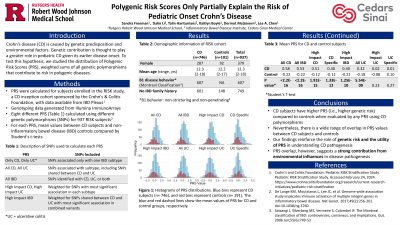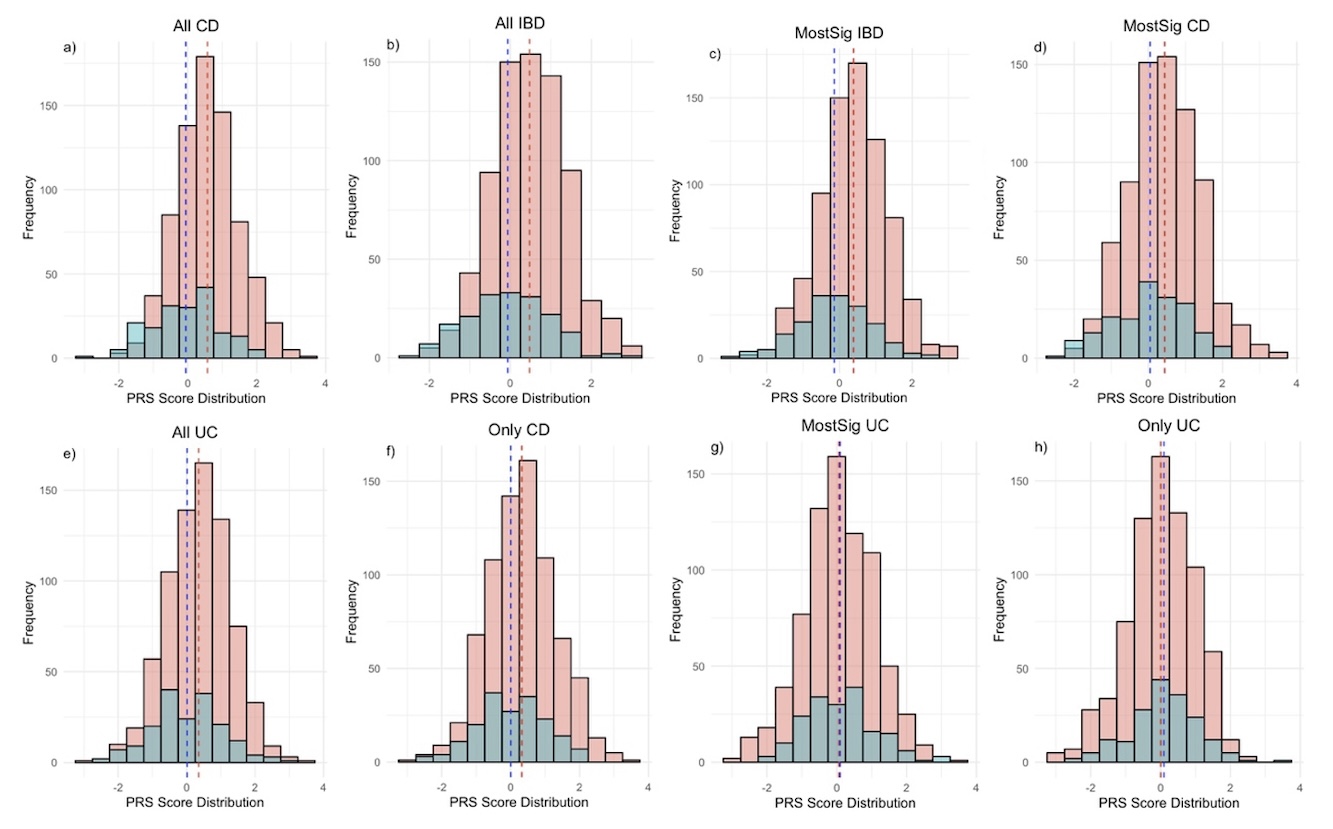Tuesday Poster Session
Category: IBD
P4394 - Polygenic Risk Scores Only Partially Explain the Risk of Pediatric Onset Crohn's Disease
Tuesday, October 29, 2024
10:30 AM - 4:00 PM ET
Location: Exhibit Hall E

Has Audio

Sandra Freeman, BA
Robert Wood Johnson Medical School, Rutgers University
New Brunwsick, NJ
Presenting Author(s)
Sandra Freeman, BA1, Dalin Li, PhD2, Talin Haritunians, MD3, Kaitlyn Boyle, MS4, Dermot McGovern, MD, PhD3, Lea A. Chen, MD5
1Robert Wood Johnson Medical School, Rutgers University, New Brunwsick, NJ; 2Cedars-Sinai Medical Center, Los Angeles, CA; 3Inflammatory Bowel Disease Center, Cedars-Sinai Medical Center, Los Angeles, CA; 4Robert Wood Johnson Medical School, Rutgers University, New Brunswick, NJ; 5Rutgers Robert Wood Johnson Medical School, New Brunswick, NJ
Introduction: Crohn’s disease (CD) is caused by both genetic predisposition and environmental factors. However, genetic contribution is thought to play a greater role in pediatric CD given its earlier onset. To test this hypothesis, we studied the distribution of polygenic risk scores (PRS) in the Pediatric Risk Stratification Study (RISK), a CD inception cohort sponsored by the Crohn’s and Colitis Foundation. Polygenic risk scores are weighted sums of all the genetic polymorphisms (SNPs) that contribute to disease risk and thereby provide a composite estimate of one’s genetic risk for a polygenic illness.
Methods: Using genotyping data generated from the Illumina ImmunoArrays, eight different PRS were calculated for 934 pediatric RISK subjects: 753 with CD and 181 without inflammatory bowel disease (IBD). The scores analyzed included some that contained SNPs associated only with one IBD subtype (e.g., Only CD) or that also included SNPs shared between CD and ulcerative colitis (UC) (e.g., All CD). Some PRS were weighted for high impact variants (e.g., MostSig CD, MostSig UC). For each PRS, the mean values between CD subjects and non-IBD controls were compared by t-tests, with statistical significance defined as a p-value < 0.05.
Results: There was no difference in age between CD subjects and non-IBD controls (p=0.84; Table 1). The PRS tested showed statistically significant increases in mean scores of CD subjects compared to controls, with the only exceptions being the two scores that did not include CD-associated variants: Only UC and MostSig UC (Table 1). The PRS with the largest difference between means were All CD and All IBD. Despite the association between PRS and CD status, there is still a wide range of overlap in PRS values between subjects with and without CD (Figure 1).
Discussion: For PRS that incorporate CD-associated SNPs, mean values are higher in CD subjects compared to non-IBD controls. This finding highlights the role of genetic risk and the utility of PRS in understanding CD pathogenesis. Nevertheless, there is a large degree of overlap in PRS values between those with and without CD, suggesting a strong contribution from environmental influences in disease pathogenesis, even among patients with pediatric onset CD. We furthermore hypothesize that environmental influences may explain why many individuals are discordant between their genetic risk for CD and their disease status.

Note: The table for this abstract can be viewed in the ePoster Gallery section of the ACG 2024 ePoster Site or in The American Journal of Gastroenterology's abstract supplement issue, both of which will be available starting October 27, 2024.
Disclosures:
Sandra Freeman, BA1, Dalin Li, PhD2, Talin Haritunians, MD3, Kaitlyn Boyle, MS4, Dermot McGovern, MD, PhD3, Lea A. Chen, MD5. P4394 - Polygenic Risk Scores Only Partially Explain the Risk of Pediatric Onset Crohn's Disease, ACG 2024 Annual Scientific Meeting Abstracts. Philadelphia, PA: American College of Gastroenterology.
1Robert Wood Johnson Medical School, Rutgers University, New Brunwsick, NJ; 2Cedars-Sinai Medical Center, Los Angeles, CA; 3Inflammatory Bowel Disease Center, Cedars-Sinai Medical Center, Los Angeles, CA; 4Robert Wood Johnson Medical School, Rutgers University, New Brunswick, NJ; 5Rutgers Robert Wood Johnson Medical School, New Brunswick, NJ
Introduction: Crohn’s disease (CD) is caused by both genetic predisposition and environmental factors. However, genetic contribution is thought to play a greater role in pediatric CD given its earlier onset. To test this hypothesis, we studied the distribution of polygenic risk scores (PRS) in the Pediatric Risk Stratification Study (RISK), a CD inception cohort sponsored by the Crohn’s and Colitis Foundation. Polygenic risk scores are weighted sums of all the genetic polymorphisms (SNPs) that contribute to disease risk and thereby provide a composite estimate of one’s genetic risk for a polygenic illness.
Methods: Using genotyping data generated from the Illumina ImmunoArrays, eight different PRS were calculated for 934 pediatric RISK subjects: 753 with CD and 181 without inflammatory bowel disease (IBD). The scores analyzed included some that contained SNPs associated only with one IBD subtype (e.g., Only CD) or that also included SNPs shared between CD and ulcerative colitis (UC) (e.g., All CD). Some PRS were weighted for high impact variants (e.g., MostSig CD, MostSig UC). For each PRS, the mean values between CD subjects and non-IBD controls were compared by t-tests, with statistical significance defined as a p-value < 0.05.
Results: There was no difference in age between CD subjects and non-IBD controls (p=0.84; Table 1). The PRS tested showed statistically significant increases in mean scores of CD subjects compared to controls, with the only exceptions being the two scores that did not include CD-associated variants: Only UC and MostSig UC (Table 1). The PRS with the largest difference between means were All CD and All IBD. Despite the association between PRS and CD status, there is still a wide range of overlap in PRS values between subjects with and without CD (Figure 1).
Discussion: For PRS that incorporate CD-associated SNPs, mean values are higher in CD subjects compared to non-IBD controls. This finding highlights the role of genetic risk and the utility of PRS in understanding CD pathogenesis. Nevertheless, there is a large degree of overlap in PRS values between those with and without CD, suggesting a strong contribution from environmental influences in disease pathogenesis, even among patients with pediatric onset CD. We furthermore hypothesize that environmental influences may explain why many individuals are discordant between their genetic risk for CD and their disease status.

Figure: Figure 1: Histograms of polygenic risk score (PRS) distributions for the following scores: (a) All Crohn’s disease (CD), (b) All inflammatory bowel disease (IBD), (c) MostSig IBD, (d) MostSig CD, (e) All ulcerative colitis (UC), (f) Only CD, (g) MostSig UC, (h) Only UC. Red bins represent CD subjects, and blue bins represent non-IBD controls. The red and blue dashed lines show the mean values of polygenic risk score (PRS) for CD and non-IBD groups, respectively.
Note: The table for this abstract can be viewed in the ePoster Gallery section of the ACG 2024 ePoster Site or in The American Journal of Gastroenterology's abstract supplement issue, both of which will be available starting October 27, 2024.
Disclosures:
Sandra Freeman indicated no relevant financial relationships.
Dalin Li indicated no relevant financial relationships.
Talin Haritunians indicated no relevant financial relationships.
Kaitlyn Boyle indicated no relevant financial relationships.
Dermot McGovern: Merck – Consultant. Prometheus Biosciences – Consultant, Stock Options. Prometheus Laboratories – Consultant. Takeda – Consultant.
Lea Chen: Bristol Myers Squibb – Advisory Committee/Board Member. Ferring – Advisory Committee/Board Member. Pfizer – Consultant, Speakers Bureau. PredictImmune – Consultant, Grant/Research Support.
Sandra Freeman, BA1, Dalin Li, PhD2, Talin Haritunians, MD3, Kaitlyn Boyle, MS4, Dermot McGovern, MD, PhD3, Lea A. Chen, MD5. P4394 - Polygenic Risk Scores Only Partially Explain the Risk of Pediatric Onset Crohn's Disease, ACG 2024 Annual Scientific Meeting Abstracts. Philadelphia, PA: American College of Gastroenterology.

